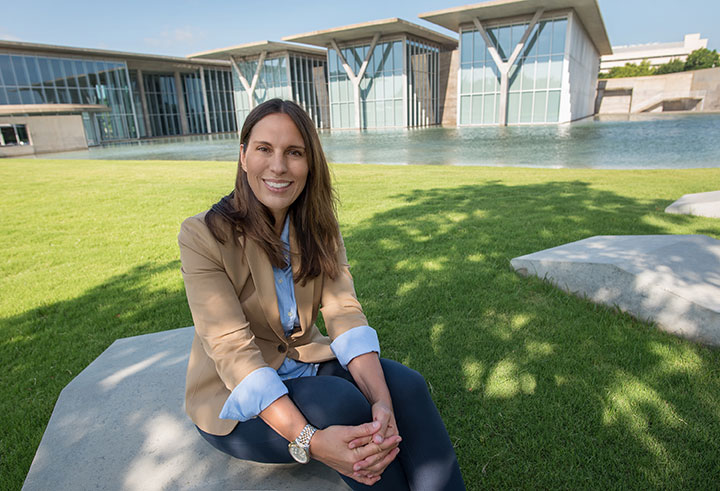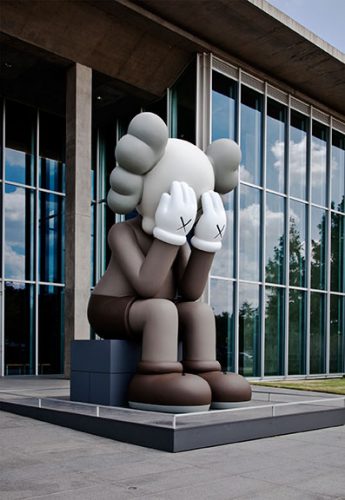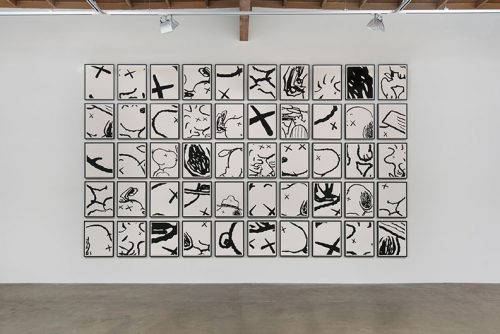Exhibiting Talent
Andrea Karnes ’01 MA found her calling ― and the rest is art history.

Andrea Karnes is curator of the Modern Art Museum of Fort Worth. (photo by Carolyn Cruz)
Exhibiting Talent
Andrea Karnes ’01 MA found her calling ― and the rest is art history.
Fresh out of college with a degree in art history, Andrea Karnes landed a receptionist job at the Modern Art Museum of Fort Worth.
It was 1989. The pay was $16,000 a year, and Karnes was blissfully “clueless.”
“I had no idea what people in museums really did. It was vague to me,” she said. “Within a year, I decided I wanted to be a curator. I didn’t know if I could do it, but I knew that is what I wanted to do.”
And do it, Karnes did ― but not without decades of study, travel, commitment and focus. She obtained a master’s degree in art history from TCU and worked her way up the career ladder.
Receptionist. Research assistant. Registrar. Assistant curator. Associate curator. Curator.

KAWS | COMPANION (PASSING THROUGH). 2010. Fiberglass, metal structure and paint. Installation view at the Modern Art Museum of Fort Worth. (photo by Heath Braun)
Karnes received her last title in 2005 and still holds it today. She has worked at the museum for 27 years. “To get as far as I’ve gotten within one institution is pretty rare,” she said. “This is my hometown, and I feel very fortunate to still be here.”
Karnes estimates she has curated about 40 exhibitions at the Modern. Curating entails conceptualizing the idea for a show, negotiating to borrow artworks, arranging how the pieces will be displayed, writing the accompanying catalog and lecturing ― basically, overseeing every detail of the project.
An exhibition that Karnes organized for more than two years ― “KAWS: Where the End Starts” ― opened in late October and closes Jan. 22. The exhibition features 20 years of work by the Brooklyn-based artist KAWS, who started as a graffiti artist and crossed over to design and fine arts. The exhibit features key paintings, sculptures, toys, street art and apparel.
“KAWS has the attention and respect of the art world,” Karnes said. “He is an influential contemporary artist among his peers, and he has a massive pop culture following. That is a rare combination. He can’t be pinned down. I like that.”
Inspired in Italy
Karnes, the daughter of a schoolteacher mother and developer father, grew up in Fort Worth. When she was 12, she took her first big trip outside Texas. Mother and daughter traveled to Europe, where Karnes learned more about her mother’s Italian heritage.
Karnes returned home mesmerized by art.
“We went to the tiny town in Italy where my mother’s relatives lived, but we also went to Rome, Florence, Venice and Milan,” she said. “We did all of the museums. I was only 12, but I don’t think I realized before that trip that whatever was being made at that time was a direct reflection of its own history and culture. I became fascinated with the tie between art and culture.”
Longing to see more of the world, Karnes signed up at 17 to become an exchange student.
“I knew that it was another means to get back to Europe and travel around,” she said. “I had the desire, and I just made it happen.” Karnes ended up in Holland, where she explored museums and the city of Leiden, the hometown of Rembrandt. “Holland is so tiny and packed with art.”
When Karnes returned from her year abroad, she attended the University of North Texas in Denton and graduated with a degree in art history. “I didn’t know what kind of job it would lead to.”

KAWS | NYT, 2016. Acrylic on canvas. Collection of the Artist. (photo courtesy of the Modern Art Museum of Fort Worth)
Layering on skills
Karnes got her foot in the door at the Modern Art Museum of Fort Worth in 1989 as a receptionist, then kept her eyes wide open.
“Getting a job on the ground floor was really the best way to observe what everyone else did,” she said. “No one had support staff. I was able to help the registrars and the curator and the director. By doing that, I figured out what everybody did … and what I wanted to do.”
Then she realized she needed a master’s degree. Karnes asked Michael Auping, chief curator at the museum, if he would write her recommendation letters to get into graduate school.
Auping told her about an opportunity at TCU, which was starting a graduate program in art history. “He said, ‘I don’t know if TCU is on your list, but if it is and you want to stay here and work while you go to graduate school, I think there will be an opportunity for you here.’ ”
Karnes was one of four students selected for the inaugural art history graduate program at TCU. One of her professors was Anne Helmreich, now dean of the College of Fine Arts. Her other professors included Mark Thistlethwaite and Babette Bohn, both still on the faculty.
“This is my hometown, and I feel very fortunate to still be here.”
Andrea Karnes
The professors “had such high standards,” Karnes said. “In retrospect, it was to my great fortune, but at the time, I thought it was so rigorous because I was working, too.”
The hard work paid off. After graduate school, she became assistant curator, associate curator and, finally, curator. Auping called Karnes one of his best hires in his 40-year career. “When I came to the Modern in 1994, Andrea was the registrar, but it didn’t take long for me to realize she was much more than that,” he said. “She knew the ins and outs of international art shipping and the complex technical aspect of caring for art.
“She also had a deep empathy for the content of art, what the artists were trying to do,” Auping said. “When it came time for me to hire another curator, Andrea was the obvious choice.”
Karnes has a reputation for bringing some of the most challenging and engaging exhibitions to the museum. “We are lucky to have Andrea’s unique vision as part of the Modern’s exhibition programming,” said Rafael G. Garza, vice president of the Modern’s board of trustees. “She is extremely talented and a hard worker who deeply cares about her profession.
“She has led the museum’s efforts on several very important and complex exhibitions. Her upcoming project with the artist KAWS is proof of that,” Garza said. “On a personal note, I enjoy working with her. She is dedicated and skilled, combining a great mix of intellect, warmth and humor.”

KAWS | MAN’S BEST FRIEND, 2014. Acrylic on paper. Collection of the Artist. (photo courtesy of the Modern Art Museum of Fort Worth)
Completing the picture
Although Karnes has worked with dozens of talented artists, she won’t say who are among her favorites. “My answer would change almost every day, at least every month,” she said, laughing. “It’s like asking somebody what their favorite song is. You like too many to actually choose ― or maybe it’s the song you are listening to right now.
“There are so many artists who are so important to every decade,” she said. And while she loves art, Karnes never aspired to be an artist herself. “I’m more like a historian,” she said. “The fascination for me has to do with the object and the history and culture. I don’t want to try and make anything.”
Although Karnes has been at the Modern for nearly three decades, the work hasn’t gotten old. She loves the building, the artists, the travel and the excitement that comes with every show. “To me, there are a lot of ‘best parts,’ ” she said. “I feel very lucky to be here and to be able to balance it with being a wife and mother. I feel like I have the energy to pursue it all.”

Your comments are welcome
Comments
Related reading:
Features
Politics 101
Students appraise the political landscape
Features
Following in Frog Footsteps
The Harris family shares lessons learned on the gridiron.